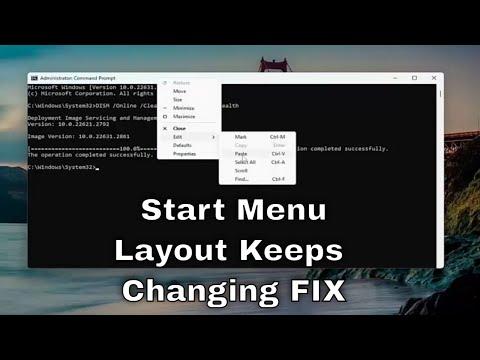I had never thought that something as simple as the Start Menu in Windows could become such a hassle. It all started one day when I turned on my computer and noticed that the Start Menu, which I had meticulously customized to fit my needs, had reset itself to its default state. It was frustrating, to say the least. Everything I had organized and arranged was gone, and the default layout was back in place. I tried to ignore it, thinking it was just a temporary glitch. But when it happened again the next day, and the day after that, I knew I had to figure out what was going on.
At first, I was baffled. Why was this happening? I hadn’t installed any new software or updates recently, and my system seemed to be running fine otherwise. I decided to do a bit of research to see if others had experienced similar issues. It turns out that this was a relatively common problem. Many people had encountered the same issue where their Start Menu kept resetting to default settings, and it seemed like a frustratingly persistent problem.
The first step I took was to check for any Windows updates. Sometimes, updates can resolve unexpected issues, and it seemed like a logical starting point. I navigated to Settings and then to Update & Security. I clicked on Check for updates and waited as Windows searched for any available updates. Fortunately, there were a couple of updates pending. I installed them and restarted my computer, hopeful that this would solve the problem. Unfortunately, the Start Menu still reset to its default state after the restart.
Next, I decided to explore some of the common troubleshooting steps that people suggested online. One of the most recommended solutions was to use the System File Checker tool, which scans for corrupted system files and attempts to repair them. To run this tool, I opened Command Prompt as an administrator and typed the command “sfc /scannow”. I let the tool do its work, and after a while, it finished scanning and repairing. However, even after this, the issue persisted.
I then turned my attention to the Windows Profile itself. It was suggested that sometimes a corrupted user profile could be the culprit behind such issues. I decided to create a new user profile and see if the problem occurred there as well. Creating a new profile was simple enough. I went to Settings, then Accounts, and selected Family & other users. I clicked on Add someone else to this PC and followed the prompts to create a new user account.
Once the new profile was set up, I logged into it and customized the Start Menu to my liking. To my relief, the new profile didn’t have the same problem. The Start Menu remained as I had arranged it, without resetting itself. This indicated that the issue was likely related to my original user profile. I decided to transfer my files and settings to the new profile and continue using it, hoping this would permanently solve the problem.
However, I wasn’t ready to give up on solving the issue with my original profile just yet. I decided to dig deeper into the problem. I explored the possibility that certain installed programs or settings could be interfering with the Start Menu. I began by checking for any recently installed applications that might be causing the problem. I went through the list of installed programs and uninstalled a few that I suspected might be problematic.
Additionally, I explored the Event Viewer to look for any error messages or warnings related to the Start Menu. To access the Event Viewer, I typed “Event Viewer” in the Start Menu search bar and opened the application. I navigated to Windows Logs and checked the Application and System logs for any relevant entries. I found a few warnings that seemed related to the Start Menu but couldn’t pinpoint an exact cause.
At this point, I decided to perform a system restore to revert my computer to a previous state before the problem started occurring. System Restore is a useful feature that allows you to roll back your system to a point in time when it was functioning correctly. I accessed System Restore through the Control Panel and followed the prompts to choose a restore point. After completing the process and restarting my computer, I was hopeful that the problem would be resolved. However, the Start Menu continued to reset to default.
Determined to find a solution, I turned to the Microsoft community forums and other online resources. I came across a suggestion to reset the Windows Store cache. The Windows Store can sometimes cause issues with various Windows features. To reset the cache, I opened Command Prompt as an administrator and entered the command “wsreset.exe”. This command resets the Windows Store without changing any settings or installed applications.
After running the command and restarting my computer, I was pleased to see that the Start Menu issue seemed to be resolved. The menu no longer reset to its default state, and I could once again customize it to my preference. It was a relief to have finally resolved the problem, but it took a fair amount of time and effort to get there.
In conclusion, troubleshooting the Start Menu issue was a multifaceted process. I started with basic steps like checking for updates and running system scans, then moved on to more in-depth solutions such as creating a new user profile and resetting the Windows Store cache. Each step brought me closer to identifying and resolving the issue. While it was a frustrating experience, I learned a lot about Windows troubleshooting and found a solution that worked.
